Types/thyroid/patient/thyroid-treatment-pdq
Thyroid Cancer Treatment (Adult) (PDQ®)–Patient Version
General Information About Thyroid Cancer
KEY POINTS
- Thyroid cancer is a disease in which malignant (cancer) cells form in the tissues of the thyroid gland.
- Thyroid nodules are common but usually are not cancer.
- There are different types of thyroid cancer.
- Age, gender, and being exposed to radiation can affect the risk of thyroid cancer.
- Medullary thyroid cancer is sometimes caused by a change in a gene that is passed from parent to child.
- Signs of thyroid cancer include a swelling or lump in the neck.
- Tests that examine the thyroid, neck, and blood are used to detect (find) and diagnose thyroid cancer.
- Certain factors affect prognosis (chance of recovery) and treatment options.
Thyroid cancer is a disease in which malignant (cancer) cells form in the tissues of the thyroid gland.
The thyroid is a gland at the base of the throat near the trachea (windpipe). It is shaped like a butterfly, with a right lobe and a left lobe. The isthmus, a thin piece of tissue, connects the two lobes. A healthy thyroid is a little larger than a quarter. It usually cannot be felt through the skin.
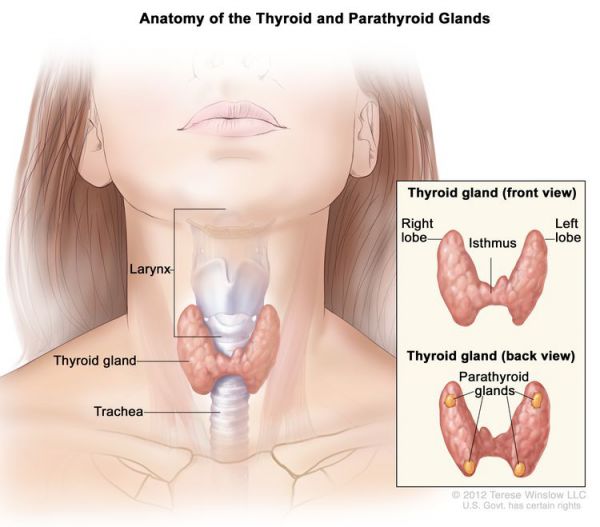
The thyroid uses iodine, a mineral found in some foods and in iodized salt, to help make several hormones. Thyroid hormones do the following:
- Control heart rate, body temperature, and how quickly food is changed into energy (metabolism).
- Control the amount of calcium in the blood.
Thyroid nodules are common but usually are not cancer.
Your doctor may find a lump (nodule) in your thyroid during a routine medical exam. A thyroid nodule is an abnormal growth of thyroid cells in the thyroid. Nodules may be solid or fluid-filled.
When a thyroid nodule is found, an ultrasound of the thyroid and a fine-needle aspiration biopsy are often done to check for signs of cancer. Blood tests to check thyroid hormone levels and for antithyroid antibodies in the blood may also be done to check for other types of thyroid disease.
Thyroid nodules usually don't cause symptoms or need treatment. Sometimes the thyroid nodules become large enough that it is hard to swallow or breathe and more tests and treatment are needed. Only a small number of thyroid nodules are diagnosed as cancer.
There are different types of thyroid cancer.
Thyroid cancer can be described as either:
- Differentiated thyroid cancer, which includes well-differentiated tumors, poorly differentiated tumors, and undifferentiated tumors; or
- Medullary thyroid cancer.
Well-differentiated tumors (papillary thyroid cancer and follicular thyroid cancer) can be treated and can usually be cured.
Poorly differentiated and undifferentiated tumors (anaplastic thyroid cancer) are less common. These tumors grow and spread quickly and have a poorer chance of recovery. Patients with anaplastic thyroid cancer should have molecular testing for a mutation in the BRAF gene.
Medullary thyroid cancer is a neuroendocrine tumor that develops in C cells of the thyroid. The C cells make a hormone (calcitonin) that helps maintain a healthy level of calcium in the blood.
See the PDQ summary on Childhood Thyroid Cancer Treatment for information about childhood thyroid cancer.
Age, gender, and being exposed to radiation can affect the risk of thyroid cancer.
Anything that increases your risk of getting a disease is called a risk factor. Having a risk factor does not mean that you will get cancer; not having risk factors doesn’t mean that you will not get cancer. Talk with your doctor if you think you may be at risk.
Risk factors for thyroid cancer include the following:
- Being between 25 and 65 years old.
- Being female.
- Being exposed to radiation to the head and neck as an infant or child or being exposed to radioactive fallout. The cancer may occur as soon as 5 years after exposure.
- Having a history of goiter (enlarged thyroid).
- Having a family history of thyroid disease or thyroid cancer.
- Having certain genetic conditions such as familial medullary thyroid cancer (FMTC), multiple endocrine neoplasia type 2A syndrome (MEN2A), or multiple endocrine neoplasia type 2B syndrome (MEN2B).
- Being Asian.
Medullary thyroid cancer is sometimes caused by a change in a gene that is passed from parent to child.
The genes in cells carry hereditary information from parent to child. A certain change in the RET gene that is passed from parent to child (inherited) may cause medullary thyroid cancer.
There is a genetic test that is used to check for the changed gene. The patient is tested first to see if he or she has the changed gene. If the patient has it, other family members may also be tested to find out if they are at increased risk for medullary thyroid cancer. Family members, including young children, who have the changed gene may have a thyroidectomy (surgery to remove the thyroid). This can decrease the chance of developing medullary thyroid cancer.
Signs of thyroid cancer include a swelling or lump in the neck.
Thyroid cancer may not cause early signs or symptoms. It is sometimes found during a routine physical exam. Signs or symptoms may occur as the tumor gets bigger. Other conditions may cause the same signs or symptoms. Check with your doctor if you have any of the following:
- A lump (nodule) in the neck.
- Trouble breathing.
- Trouble swallowing.
- Pain when swallowing.
- Hoarseness.
Tests that examine the thyroid, neck, and blood are used to detect (find) and diagnose thyroid cancer.
The following tests and procedures may be used:
- Physical exam and history: An exam of the body to check general signs of health, including checking for signs of disease, such as lumps (nodules) or swelling in the neck, voice box, and lymph nodes, and anything else that seems unusual. A history of the patient’s health habits and past illnesses and treatments will also be taken.
- Laryngoscopy: A procedure in which the doctor checks the larynx (voice box) with a mirror or a laryngoscope. A laryngoscope is a thin, tube-like instrument with a light and a lens for viewing. A thyroid tumor may press on vocal cords. The laryngoscopy is done to see if the vocal cords are moving normally.
- Blood hormone studies: A procedure in which a blood sample is checked to measure the amounts of certain hormones released into the blood by organs and tissues in the body. An unusual (higher or lower than normal) amount of a substance can be a sign of disease in the organ or tissue that makes it. The blood may be checked for abnormal levels of thyroid-stimulating hormone (TSH). TSH is made by the pituitary gland in the brain. It stimulates the release of thyroid hormone and controls how fast follicular thyroid cells grow. The blood may also be checked for high levels of the hormone calcitonin and antithyroid antibodies.
- Blood chemistry studies: A procedure in which a blood sample is checked to measure the amounts of certain substances, such as calcium, released into the blood by organs and tissues in the body. An unusual (higher or lower than normal) amount of a substance can be a sign of disease.
- Ultrasound exam: A procedure in which high-energy sound waves (ultrasound) are bounced off internal tissues or organs in the neck and make echoes. The echoes form a picture of body tissues called a sonogram. The picture can be printed to be looked at later. This procedure can show the size of a thyroid nodule and whether it is solid or a fluid-filled cyst. Ultrasound may be used to guide a fine-needle aspiration biopsy.
- CT scan (CAT scan): A procedure that makes a series of detailed pictures of areas inside the body, such as the neck, taken from different angles. The pictures are made by a computer linked to an x-ray machine. A dye may be injected into a vein or swallowed to help the organs or tissues show up more clearly. This procedure is also called computed tomography, computerized tomography, or computerized axial tomography.
- Fine-needle aspiration biopsy of the thyroid: The removal of thyroid tissue using a thin needle. The needle is inserted through the skin into the thyroid. Several tissue samples are removed from different parts of the thyroid. A pathologist views the tissue samples under a microscope to look for cancer cells. Because the type of thyroid cancer can be hard to diagnose, patients should ask to have biopsy samples checked by a pathologist who has experience diagnosing thyroid cancer.
- Surgical biopsy: The removal of the thyroid nodule or one lobe of the thyroid during surgery so the cells and tissues can be viewed under a microscope by a pathologist to check for signs of cancer. Because the type of thyroid cancer can be hard to diagnose, patients should ask to have biopsy samples checked by a pathologist who has experience diagnosing thyroid cancer.
Certain factors affect prognosis (chance of recovery) and treatment options.
The prognosis (chance of recovery) and treatment options depend on the following:
- The age of the patient at the time of diagnosis.
- The type of thyroid cancer.
- The stage of the cancer.
- Whether the cancer was completely removed by surgery.
- Whether the patient has multiple endocrine neoplasia type 2B (MEN 2B).
- The patient's general health.
- Whether the cancer has just been diagnosed or has recurred (come back).
Stages of Thyroid Cancer
KEY POINTS
- After thyroid cancer has been diagnosed, tests are done to find out if cancer cells have spread within the thyroid or to other parts of the body.
- There are three ways that cancer spreads in the body.
- Cancer may spread from where it began to other parts of the body.
- Stages are used to describe thyroid cancer based on the type of thyroid cancer and the age of the patient:
- Papillary and follicular thyroid cancer in patients younger than 55 years
- Papillary and follicular thyroid cancer in patients 55 years and older
- Anaplastic thyroid cancer in patients of all ages
- Medullary thyroid cancer in patients of all ages
After thyroid cancer has been diagnosed, tests are done to find out if cancer cells have spread within the thyroid or to other parts of the body.
The process used to find out if cancer has spread within the thyroid or to other parts of the body is called staging. The information gathered from the staging process determines the stage of the disease. It is important to know the patient's age and the stage of the cancer to plan treatment.
The following tests and procedures may be used in the staging process:
- CT scan (CAT scan): A procedure that makes a series of detailed pictures of areas inside the body, such as the chest, abdomen, and brain, taken from different angles. The pictures are made by a computer linked to an x-ray machine. A dye may be injected into a vein or swallowed to help the organs or tissues show up more clearly. This procedure is also called computed tomography, computerized tomography, or computerized axial tomography.
- Ultrasound exam: A procedure in which high-energy sound waves (ultrasound) are bounced off internal tissues or organs and make echoes. The echoes form a picture of body tissues called a sonogram. The picture can be printed to be looked at later.
- Chest x-ray: An x-ray of the organs and bones inside the chest. An x-ray is a type of energy beam that can go through the body and onto film, making a picture of areas inside the body.
- Bone scan: A procedure to check if there are rapidly dividing cells, such as cancer cells, in the bone. A very small amount of radioactive material is injected into a vein and travels through the bloodstream. The radioactive material collects in the bones with cancer and is detected by a scanner.
- Sentinel lymph node biopsy: The removal of the sentinel lymph node during surgery. The sentinel lymph node is the first lymph node in a group of lymph nodes to receive lymphatic drainage from the primary tumor. It is the first lymph node the cancer is likely to spread to from the primary tumor. A radioactive substance and/or blue dye is injected near the tumor. The substance or dye flows through the lymph ducts to the lymph nodes. The first lymph node to receive the substance or dye is removed. A pathologist views the tissue under a microscope to look for cancer cells. If cancer cells are not found, it may not be necessary to remove more lymph nodes.
There are three ways that cancer spreads in the body.
Cancer can spread through tissue, the lymph system, and the blood:
- Tissue. The cancer spreads from where it began by growing into nearby areas.
- Lymph system. The cancer spreads from where it began by getting into the lymph system. The cancer travels through the lymph vessels to other parts of the body.
- Blood. The cancer spreads from where it began by getting into the blood. The cancer travels through the blood vessels to other parts of the body.
Cancer may spread from where it began to other parts of the body.
When cancer spreads to another part of the body, it is called metastasis. Cancer cells break away from where they began (the primary tumor) and travel through the lymph system or blood.
- Lymph system. The cancer gets into the lymph system, travels through the lymph vessels, and forms a tumor (metastatic tumor) in another part of the body.
- Blood. The cancer gets into the blood, travels through the blood vessels, and forms a tumor (metastatic tumor) in another part of the body.
The metastatic tumor is the same type of cancer as the primary tumor. For example, if thyroid cancer spreads to the lung, the cancer cells in the lung are actually thyroid cancer cells. The disease is metastatic thyroid cancer, not lung cancer.
Stages are used to describe thyroid cancer based on the type of thyroid cancer and the age of the patient:
Papillary and follicular thyroid cancer in patients younger than 55 years
- Stage I: In stage I papillary and follicular thyroid cancer, the tumor is any size and may have spread to nearby tissues and lymph nodes. Cancer has not spread to other parts of the body.
- Stage II: In stage II papillary and follicular thyroid cancer, the tumor is any size and cancer may have spread to nearby tissues and lymph nodes. Cancer has spread from the thyroid to other parts of the body, such as the lungs or bones.
Papillary and follicular thyroid cancer in patients 55 years and older
- Stage I: In stage I papillary and follicular thyroid cancer, cancer is found in the thyroid only and the tumor is 4 centimeters or smaller.
- Stage II: In stage II papillary and follicular thyroid cancer, one of the following is found:
- cancer is found in the thyroid and the tumor is 4 centimeters or smaller; cancer has spread to nearby lymph nodes; or
- cancer is found in the thyroid, the tumor is larger than 4 centimeters, and cancer may have spread to nearby lymph nodes; or
- the tumor is any size and cancer has spread from the thyroid to nearby muscles in the neck and may have spread to nearby lymph nodes.
- Stage III: In stage III papillary and follicular thyroid cancer, the tumor is any size and cancer has spread from the thyroid to soft tissue under the skin, the esophagus, the trachea, the larynx, or the recurrent laryngeal nerve (a nerve that goes to the larynx). Cancer may have spread to lymph nodes.
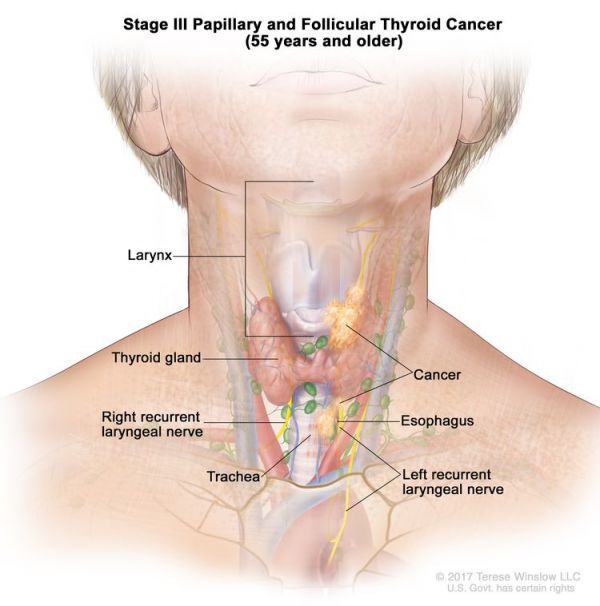
- Stage IV: Stage IV papillary and follicular thyroid cancer is divided into stages IVA and IVB.
- In stage IVA, the tumor is any size and cancer has spread to tissue in front of the spine or has surrounded the carotid artery or the blood vessels in the area between the lungs. Cancer may have spread to lymph nodes.
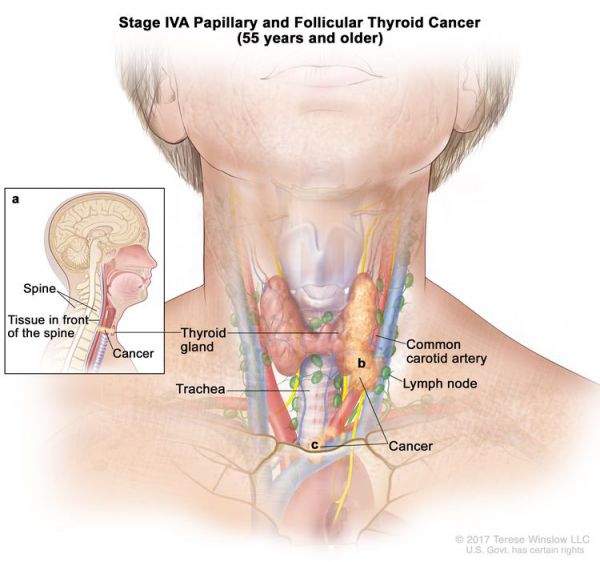
- In stage IVB, the tumor is any size and cancer has spread to other parts of the body, such as the lungs or bones. Cancer may have spread to lymph nodes.
Anaplastic thyroid cancer in patients of all ages
Anaplastic thyroid cancer grows quickly and usually has spread within the neck when it is found. Anaplastic thyroid cancer is considered stage IV thyroid cancer. Stage IV anaplastic thyroid cancer is divided into stages IVA, IVB, and IVC.
- In stage IVA, cancer is found in the thyroid only and the tumor may be any size.
- In stage IVB, one of the following is found:
- cancer is found in the thyroid and the tumor may be any size; cancer has spread to nearby lymph nodes; or
- the tumor is any size and cancer has spread from the thyroid to nearby muscles in the neck and may have spread to nearby lymph nodes; or
- the tumor is any size and cancer has spread from the thyroid to soft tissue under the skin, the esophagus, the trachea, the larynx, the recurrent laryngeal nerve (a nerve that goes to the larynx), or tissue in front of the spine, or has surrounded the carotid artery or the blood vessels in the area between the lungs; cancer may have spread to lymph nodes.

- In stage IVC, the tumor is any size and cancer has spread to other parts of the body, such as the lungs or bones. Cancer may have spread to lymph nodes.
Medullary thyroid cancer in patients of all ages
- Stage I: In stage I medullary thyroid cancer, cancer is found in the thyroid only and the tumor is 2 centimeters or smaller.
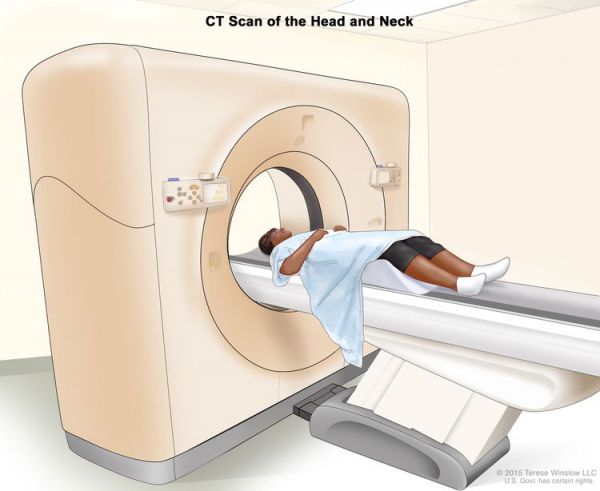
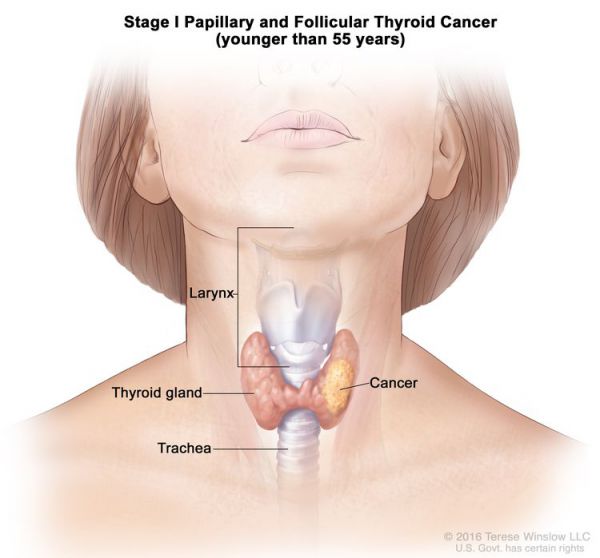
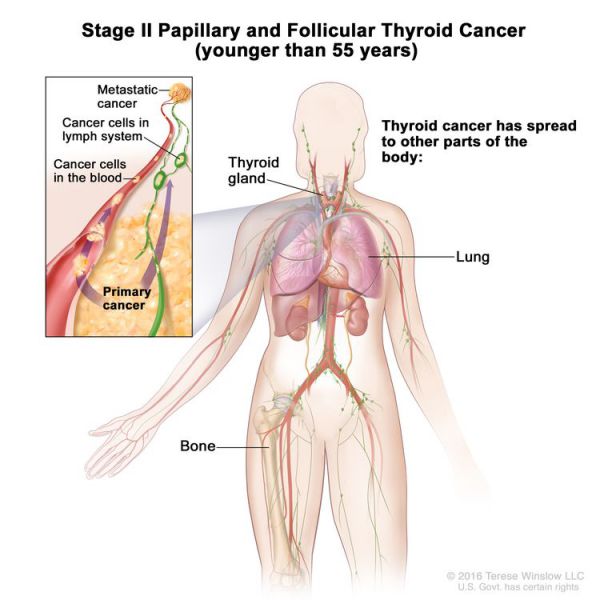
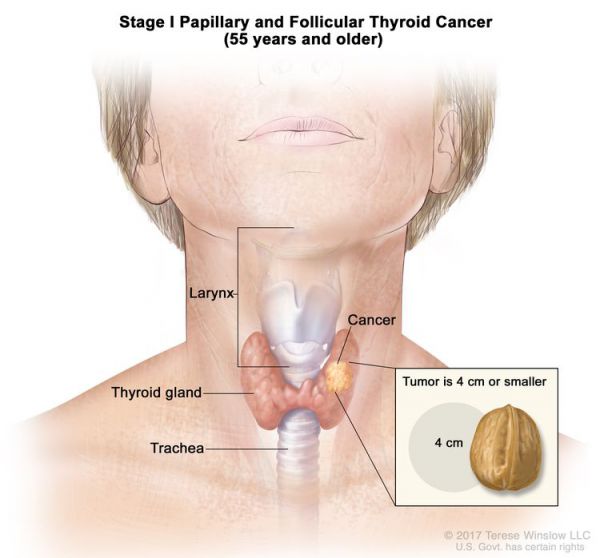
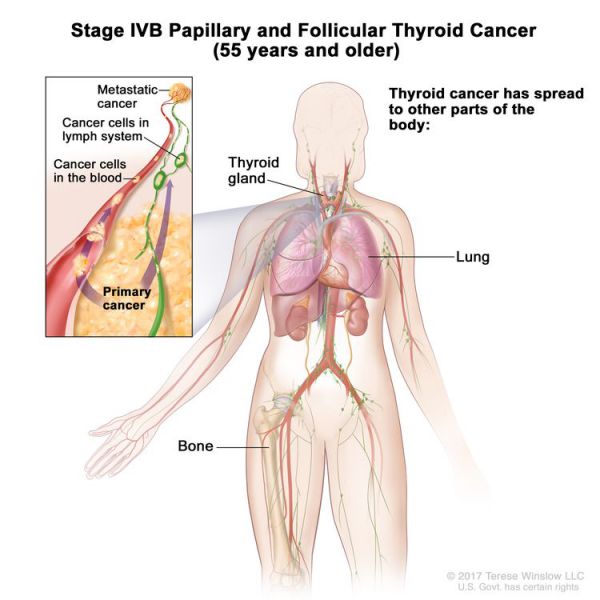
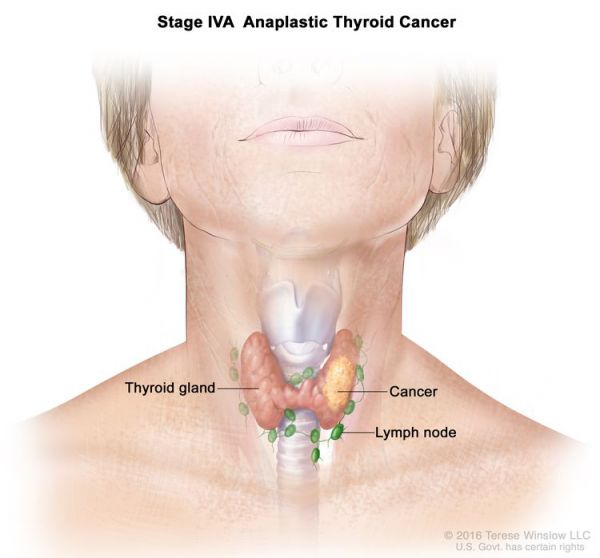

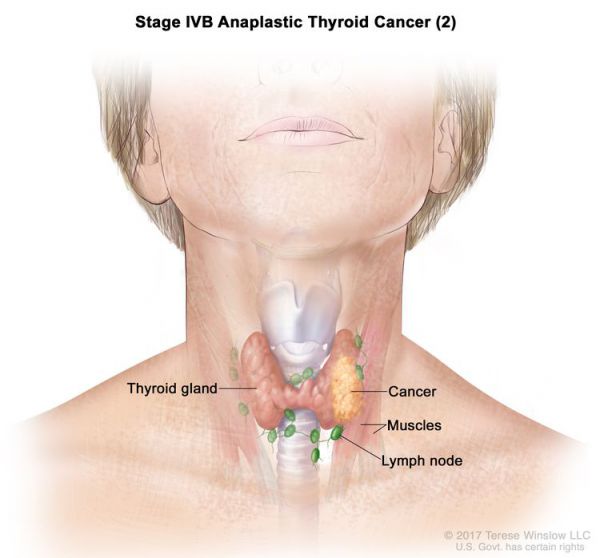
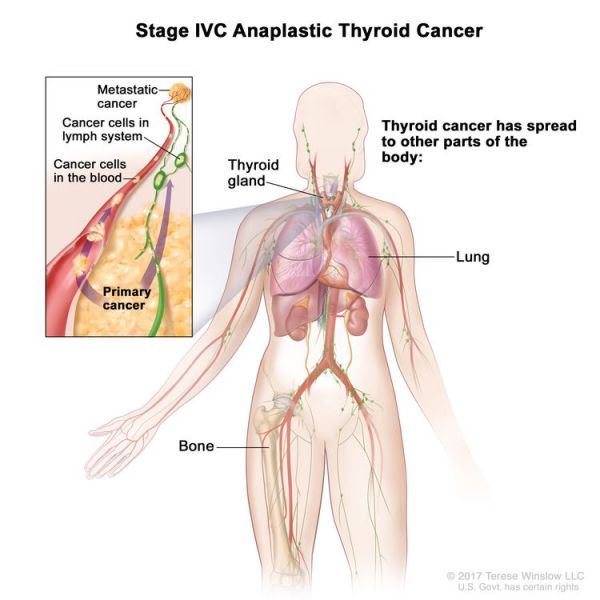
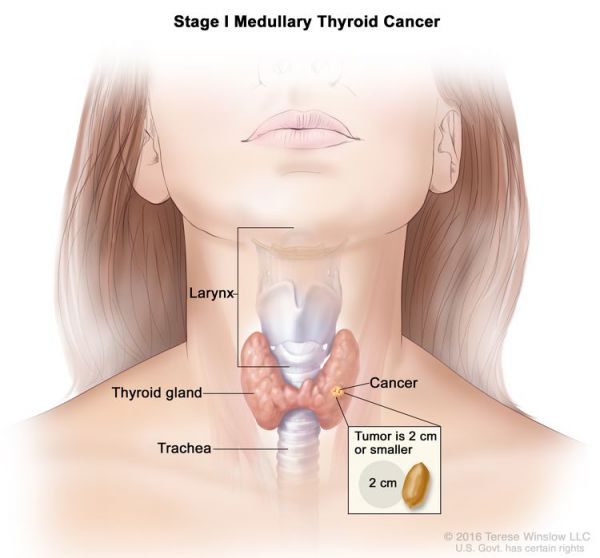
Enable comment auto-refresher